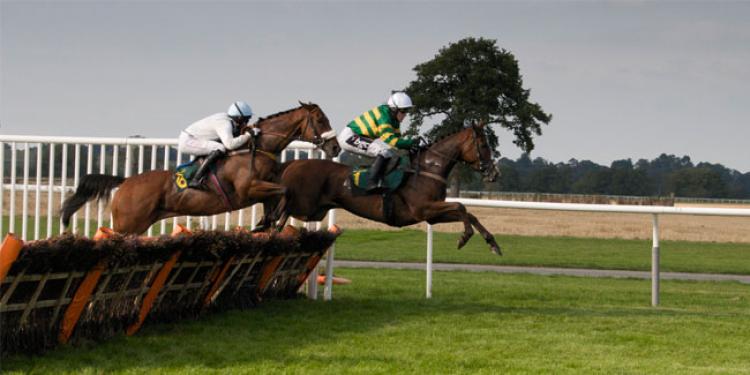Horse Racing 103: The Types of Horse Races Explained
Posted: March 17, 2016
Updated: March 17, 2016

The next part in our Horse Racing Series, Horse Racing 103 –The Types of Horse Races Explained, will be a comprehensive and hopefully painless illustration of these tricky and numerous variations of races. Here we will focus on the Types of horse races and explain them. We also advise you to take a look at the Cheltenham Festival 2016 practice your newfound knowledge on horse betting!
If you bet on sports in the UK you'll know this variety: The Cheltenham Festival is filled with these races. These are the races that involve jumping over obstacles mostly known as the Hurdles and Steeplechases. This is when the horses must determine and overcome the challenges of fences, open ditches and water jumps. Hurdles will be substituted with bushes too on occasion as well as harder objects to force the horse to exaggerate their jumping form into what has become popularized in advertising images.
The National Hunt Races take place between autumn and spring due to the softness of the ground which buffers the jumps and therefore minimalize the possiblity of injury to horses and jockeys should they fall. This is also the most popular racing in Britain, Ireland and France.
Types of National Hunt Races
Chase: This is a run and jump course of distances between 2 to 4.5 miles.
Hurdling: This is a race that has runs between 2 to 3.5 miles and also with hurdles or jumps that are at a minimum of 3.5 feet high.
National Hunt Flat Race (NH Flat): AKA bumper races. Races in which horses who have never competed before participate in both flat racing and jumping. They also have to run between 1.5 to 2.5 miles.
Races in which the horses are to run between 1-2.3 miles. These races are also named sprints, middle distance and stayers races. You'll be very familiar with these if you bet on sports in the US.
Pattern Races: commonly known as group races.
Listed Races: Less esteemed than group races though more important than handicap races.
Handicap Races: A race when the horses are given a different weight according to their ability by the Jockey Club official handicapper. These are the most popular race, always in gambling news and the biggest money maker. Both prestigious and average levels to suit all racing interests.

Allowance: Weights and eligibility determine this race by the conditions set by the racing secretary.
Baby Race: 2 year old horses are eligible and can compete
Claiming Race: When horses are enlisted for sale for a stated price. They can be purchased or “claimed” for that price at the race. Horses in these races are usually referred to as “claimers” and only run in claiming races.
Classic: These are for 3 year old horses. Popular UK Classics are Derby or Oaks. In the US; Kentucky Derby, Belmont Stakes and Preakness.
Conditioned Race: A set of conditions are referred to when evaluating eligibility of a horse. Such conditions considered are: age, sex, races won and so on.
Derby: Three year old colts that run in a stakes race.
Distaff Race: Races geared only for fillies and/or mares.
Group Race: Probably the most important and prestigious races (under Flat Race description)
Handicap: Weights to be carried by horse which are assigned by racing secretary.
Invitational: A no entry fee stakes race open to horses invited to enter.
Maiden Race: A race for “non-winners” or horses who have not won a race yet. These horses are also called maidens.
Oaks: 3 year old fillie stakes race.
Overnight Race: Different from a stakes race where nominations close in advance, these races are when entries close a specific number of hours before running.
Route Race: A race that is roughly two turns on the track.
Scale of Weights: Weights that are to be carried by horses in a race categorized by age, distance run, sex and time of year.
Sprint Race: A race of one turn on the track.
Stake: When an owner of a horse must pay an entry fee for his horse to run a race. These fees can contribute to nominating, keeping up eligibility, admittance and starting, and usually added to the amount put together by the track of collective money.
National Hunt aka Jump Races
If you bet on sports in the UK you'll know this variety: The Cheltenham Festival is filled with these races. These are the races that involve jumping over obstacles mostly known as the Hurdles and Steeplechases. This is when the horses must determine and overcome the challenges of fences, open ditches and water jumps. Hurdles will be substituted with bushes too on occasion as well as harder objects to force the horse to exaggerate their jumping form into what has become popularized in advertising images.
The National Hunt Races take place between autumn and spring due to the softness of the ground which buffers the jumps and therefore minimalize the possiblity of injury to horses and jockeys should they fall. This is also the most popular racing in Britain, Ireland and France.
Types of National Hunt Races
Chase: This is a run and jump course of distances between 2 to 4.5 miles.
Hurdling: This is a race that has runs between 2 to 3.5 miles and also with hurdles or jumps that are at a minimum of 3.5 feet high.
National Hunt Flat Race (NH Flat): AKA bumper races. Races in which horses who have never competed before participate in both flat racing and jumping. They also have to run between 1.5 to 2.5 miles.
Flat Racing
Races in which the horses are to run between 1-2.3 miles. These races are also named sprints, middle distance and stayers races. You'll be very familiar with these if you bet on sports in the US.
Pattern Races: commonly known as group races.
- Group 1: These are races of international standards and priority
- Group 2: International races of a lesser importance than 1
- Group 3: Domestic Races
Listed Races: Less esteemed than group races though more important than handicap races.
Handicap Races: A race when the horses are given a different weight according to their ability by the Jockey Club official handicapper. These are the most popular race, always in gambling news and the biggest money maker. Both prestigious and average levels to suit all racing interests.

The Kentucky Derby is a "classic", just one of many race varieties! (Photo: CNN)
So Now That You Have The Most Obvious Types of Races Explained, We Give You Just a Few More To Add To Your Roster of Racing Knowledge
Allowance: Weights and eligibility determine this race by the conditions set by the racing secretary.
Baby Race: 2 year old horses are eligible and can compete
Claiming Race: When horses are enlisted for sale for a stated price. They can be purchased or “claimed” for that price at the race. Horses in these races are usually referred to as “claimers” and only run in claiming races.
Classic: These are for 3 year old horses. Popular UK Classics are Derby or Oaks. In the US; Kentucky Derby, Belmont Stakes and Preakness.
Conditioned Race: A set of conditions are referred to when evaluating eligibility of a horse. Such conditions considered are: age, sex, races won and so on.
Derby: Three year old colts that run in a stakes race.
Distaff Race: Races geared only for fillies and/or mares.
Group Race: Probably the most important and prestigious races (under Flat Race description)
Handicap: Weights to be carried by horse which are assigned by racing secretary.
Invitational: A no entry fee stakes race open to horses invited to enter.
Maiden Race: A race for “non-winners” or horses who have not won a race yet. These horses are also called maidens.
Oaks: 3 year old fillie stakes race.
Overnight Race: Different from a stakes race where nominations close in advance, these races are when entries close a specific number of hours before running.
Route Race: A race that is roughly two turns on the track.
Scale of Weights: Weights that are to be carried by horses in a race categorized by age, distance run, sex and time of year.
Sprint Race: A race of one turn on the track.
Stake: When an owner of a horse must pay an entry fee for his horse to run a race. These fees can contribute to nominating, keeping up eligibility, admittance and starting, and usually added to the amount put together by the track of collective money.
Related content
Subscribe
0 Comments












